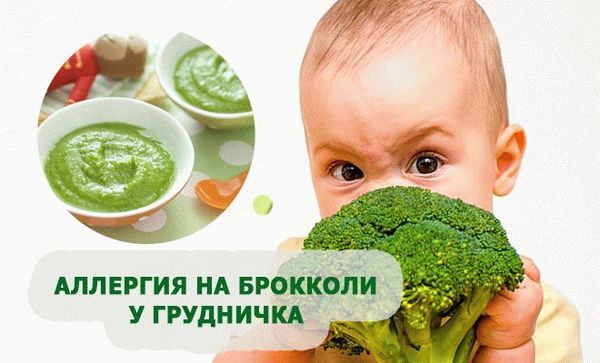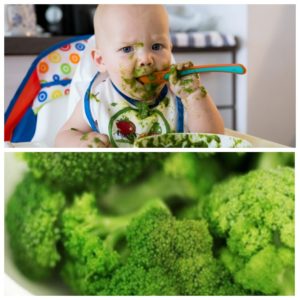Symptoms and treatment of broccoli allergy in infants
Broccoli is rich in vitamins and minerals that a child needs for proper growth and formation of all systems and organs. Although experts classify this type of cabbage as one of the most hypoallergenic foods, the body of some children produces an allergic reaction when consuming it.
Can you be allergic to broccoli?

Not a single product, even the most hypoallergenic, excludes the development of individual intolerance to one of its components. A child’s immature digestive system is not always able to digest the proteins contained in cabbage. This depends on the individual characteristics of the formation of the body and the secretion of the necessary enzymes.
The main reasons for the development of an allergic response in infants are:
- Immaturity of the immune system. An unfamiliar protein is mistakenly perceived as dangerous, requiring rejection, which is why the fragile body reacts violently to it.
- Hereditary predisposition.
- Dysbacteriosis.
- Cross allergic reactions to other types of cabbage (cauliflower, Brussels sprouts, cabbage), as well as to peaches and radishes.
The reason for the development baby has allergies broccoli is often affected by substances that were used to process the plant during growth and storage, and additives in ready-made vegetable purees.
Broccoli - allergen or not?
The vegetable itself is a very weak allergen. A hyperreaction from the body is caused by a large amount of vitamin C, the amino acids phenylalanine and tryptophan.The stem of broccoli contains chitinase, which is similar in chemical properties and effects on the body to the pollen of some plants.
Symptoms and reactions to broccoli in infants
An allergic reaction occurs either immediately after eating (immediate type reaction) or within 2-3 days after consumption (delayed type reaction). On average, the period ranges from 3 to 72 hours.

The symptoms of such an immune response vary widely. The most common:
- skin manifestations in the form of rash, red spots, peeling;
- itching of the skin, often accompanying rash and redness;
- swelling and redness of the eyelids, lacrimation, itching of the mucous membrane of the eyelids;
- flatulence, dyspeptic symptoms, stool disorders.
In especially severe cases, two life-threatening conditions develop:
- Quincke's edema: swelling of the lips, eyelids, cheeks, mucous membranes of the mouth and larynx, difficulty breathing, nausea, abdominal pain, vomiting;
- anaphylactic shock: a sharp drop in blood pressure accompanied by impaired consciousness.
When the first symptoms of an allergy to complementary feeding broccoli appear, it is necessary to urgently take the child to the hospital in order to avoid the development of a deeper reaction, which can lead to respiratory arrest and death.
This is interesting:
Can an allergy to carrots occur, how does it manifest itself and how is it treated?
What to do if you are allergic to pumpkin: treat effectively and prevent in advance
Can an allergy to rice occur and how does it manifest itself?
Allergy treatment

The basis of allergy treatment is a diet with complete elimination (elimination) of the cause of the immune response from the diet. It is advisable to remove foods with which cross-allergy is possible: all types of cabbage, radishes and peaches.After some time, broccoli can be introduced into the diet as the gastrointestinal tract and immune system grow and develop. However, repeated introduction of the product is carried out under the supervision of an allergist.
Reference. If any allergic reaction occurs, it is important to visit a doctor and conduct additional diagnostics to avoid problems in the future. You cannot self-medicate.
Treatment of symptoms
Symptomatic therapy is aimed at eliminating the external manifestations of an allergic reaction. Drugs to relieve symptoms can be local or systemic. The first ones fight rashes and itching of the skin, reduce swelling. They mainly contain antihistamine components, but in severe cases, drugs with corticosteroids are prescribed.
Systemic drugs are taken orally and act on the immune system, reducing the amount of antigens in the blood and thereby reducing the level of the allergic response. For children, the products are available in the form of syrup or drops. To speed up the removal of the allergen from the gastrointestinal tract, enterosorbents (activated carbon, Polysorb) are prescribed.
Important! Anaphylactic shock and Quincke's edema require emergency care and treatment in a hospital setting. To eliminate them, antihistamines and corticosteroids are administered in injection form, which allows the attack to be stopped more quickly.
To restore the microflora during dyspeptic manifestations, symbiotics are used. When cough and bronchospasm occur, antitussives and bronchodilators are prescribed.
Prevention of allergic reactions

To reduce the risk of allergies, new foods are introduced into the child’s diet gradually, with the obligatory keeping of a food diary.Complementary foods are added in very small portions, starting from 5–10 g per day, preferably with short breaks of 2–3 days, to avoid false diagnosis of allergies.
To ease the load on the fragile gastrointestinal tract, other, less allergenic and lighter foods are introduced into the diet before broccoli. Baby nutrition experts recommend giving cabbage puree no more than 2 times a week, separately from other foods.
Reference. The stems of young bushes are brittle, while adults, filled with chitinase, are very elastic and difficult to break.
It is better not to use ready-made vegetable purees as complementary foods - due to the addition of stabilizers and thickeners to them, the likelihood of an allergic reaction increases. For self-cooking broccoli They prefer young inflorescences with a rich green tint.
Conclusion
Is broccoli an allergenic product or not? The immune system of infants sometimes produces an atypical reaction to cabbage, especially in the presence of a hereditary predisposition and hypersensitivity to other foods. A hyperresponse in children can manifest itself both immediately after eating cabbage and several days later. To avoid this, introduce broccoli into the diet with caution, making the puree yourself if possible. If an allergic reaction occurs in response to complementary foods, the product is temporarily removed from the diet.